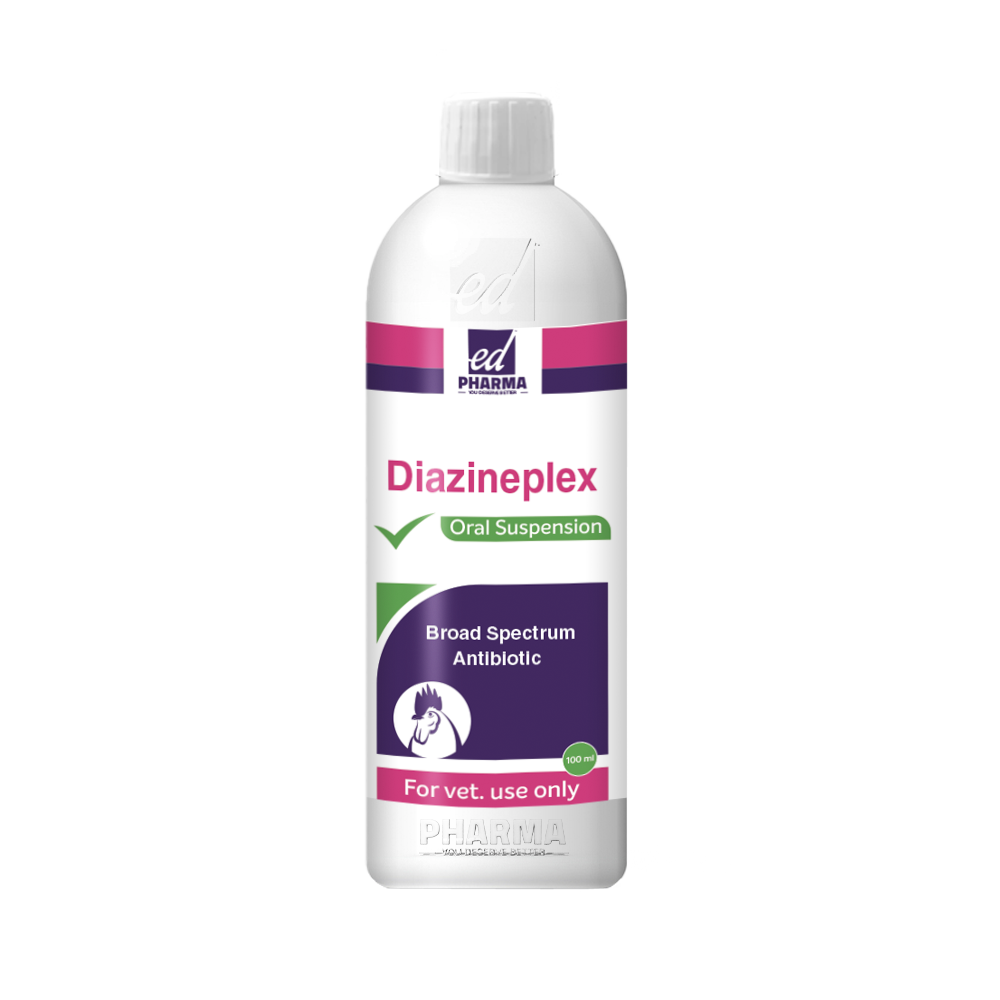DIAZINEPLEX
DIAZINEPLEX
DIAZINEPLEX
Oral suspension
(For vet. use only)
DIAZINEPLEX
Each 1 ml contains:
Sulfadiazine 400 mg
Trimethoprim 80 mg
Sulfadiazine 400 mg
Trimethoprim 80 mg
– Sulfadiazine is a sulfonamide antibiotic.
– Trimethoprim is a diaminopyrimidine antimicrobial agent which is effective against wide range of both Gram – positive and Gram-negative organism.
– Folates are essential to the bacterial/protozoal cell for multiplication and survival.
– Sulphadiazine prevents the bacterial/protozoal cell from synthesising folic acid.
– Trimethoprim prevents the conversion of folic acid to folinic acid in the bacterial/protozoal cell, by inhibiting the bacterial/protozoal enzyme-dihydrofolate reductase.
– Trimethoprim – sulphonamide:
– The two active ingredients produce a sequential double blockade of bacterial synthesis of folinic acid, giving a level of activity many times greater than either drug alone.
– The action of this combination is bactericidal, where as the components used separately are generally bacteriostatic. Potentiation is shown even against bacteria that are generally resistant to one or other of the components. – Trimethoprim – sulfadiazine antibacterial spectrum covers a range of both Gram – positive and – negative
microbes. Usually sensitive to the following Gram positive bacteria: S. aureus, Streptococcus sp., Actinomyces sp., Corynebacterium sp. E. rhusiopathiae, L. monocytogenes. and Gram negative bacteria as follows:
Actinobacillus sp.; Bordetella sp. and Enterobacteriaceae:
E. coli, Klebsiella sp. Proteus sp. Yersinia sp.; Haemophilus sp. Susceptible anaerobic bacteria include:
Actinomyces sp., Bacteroides sp.; Fusobacterium sp. and some of the Clostridium sp.
– Trimethoprim is a diaminopyrimidine antimicrobial agent which is effective against wide range of both Gram – positive and Gram-negative organism.
– Folates are essential to the bacterial/protozoal cell for multiplication and survival.
– Sulphadiazine prevents the bacterial/protozoal cell from synthesising folic acid.
– Trimethoprim prevents the conversion of folic acid to folinic acid in the bacterial/protozoal cell, by inhibiting the bacterial/protozoal enzyme-dihydrofolate reductase.
– Trimethoprim – sulphonamide:
– The two active ingredients produce a sequential double blockade of bacterial synthesis of folinic acid, giving a level of activity many times greater than either drug alone.
– The action of this combination is bactericidal, where as the components used separately are generally bacteriostatic. Potentiation is shown even against bacteria that are generally resistant to one or other of the components. – Trimethoprim – sulfadiazine antibacterial spectrum covers a range of both Gram – positive and – negative
microbes. Usually sensitive to the following Gram positive bacteria: S. aureus, Streptococcus sp., Actinomyces sp., Corynebacterium sp. E. rhusiopathiae, L. monocytogenes. and Gram negative bacteria as follows:
Actinobacillus sp.; Bordetella sp. and Enterobacteriaceae:
E. coli, Klebsiella sp. Proteus sp. Yersinia sp.; Haemophilus sp. Susceptible anaerobic bacteria include:
Actinomyces sp., Bacteroides sp.; Fusobacterium sp. and some of the Clostridium sp.
Broiler chickens: For the control and treatment of:
– Omphalitis, or (Navel ill, “Mushy chick” disease, Yolk sac infection): caused by infection with S aureus.
– Colibacillosis (Colisepticemia, Escherichia infection): caused by infection with Escherichia coli.
– Erysipelas disease caused by infection with Erysipelothrix rhusiopathiae – Paratyphoid Infections: caused by infection with S Typhimurium, S Enteritidis.
– Fowl Cholera caused by infection with Pasteurella multocida.
– Omphalitis, or (Navel ill, “Mushy chick” disease, Yolk sac infection): caused by infection with S aureus.
– Colibacillosis (Colisepticemia, Escherichia infection): caused by infection with Escherichia coli.
– Erysipelas disease caused by infection with Erysipelothrix rhusiopathiae – Paratyphoid Infections: caused by infection with S Typhimurium, S Enteritidis.
– Fowl Cholera caused by infection with Pasteurella multocida.
Broiler chickens.
Route: Orally via drinking water.
For Whole Product:
Broiler chickens: 1.56 ml per 5 liters daily for 5 days.
For Whole Product:
Broiler chickens: 1.56 ml per 5 liters daily for 5 days.
– All other sources of water should be removed during the entire period of treatment.
– Sulfonamide-containing products may interact with methotrexate, phenylbutazone, phenytoin, and salicylates.
– Sulfonamide-containing products should not be used at the same time: procaine or other p-amino benzoic acid or its derivatives containing drugs.
– To avoid the possibility of crystalluria, adequate water intake is essential.
– Use of the product should be based on susceptibility testing and take into account official and local antimicrobial procedures.
– Sulfonamide-containing products may interact with methotrexate, phenylbutazone, phenytoin, and salicylates.
– Sulfonamide-containing products should not be used at the same time: procaine or other p-amino benzoic acid or its derivatives containing drugs.
– To avoid the possibility of crystalluria, adequate water intake is essential.
– Use of the product should be based on susceptibility testing and take into account official and local antimicrobial procedures.
– Don’t use in birds which are producing eggs or may in the future produce egg or egg products for human consumption.
– Don’t mix with other drinking water medication (note squaps on crop milk cannot be effectively medicated by drinking water medication of parent birds.)
– Do not use in animals with known hypersensitivity to the active ingredients.
– Do not use in cases with severe liver parenchymal damage.
– Don’t mix with other drinking water medication (note squaps on crop milk cannot be effectively medicated by drinking water medication of parent birds.)
– Do not use in animals with known hypersensitivity to the active ingredients.
– Do not use in cases with severe liver parenchymal damage.
May occur: polyarthritis, vomiting, loss of appetite, diarrhea, and fever.
Anaphylaxis and other hypersensitivity reactions are possible.
Sulfonamide-containing products can cause crystalluria.
Anaphylaxis and other hypersensitivity reactions are possible.
Sulfonamide-containing products can cause crystalluria.
Broiler chickens (Meat):
– Don’t use less than 10 days before slaughter for human consumption.
– Don’t use less than 10 days before slaughter for human consumption.
Store at temperature not exceeding 30°C.
White HDPE plastic bottle contain 100 ml oral suspension closed with white HDPE plastic cap
and PTFE (polytetrafluoroethylene)plastic internal foam liner with outer label.
